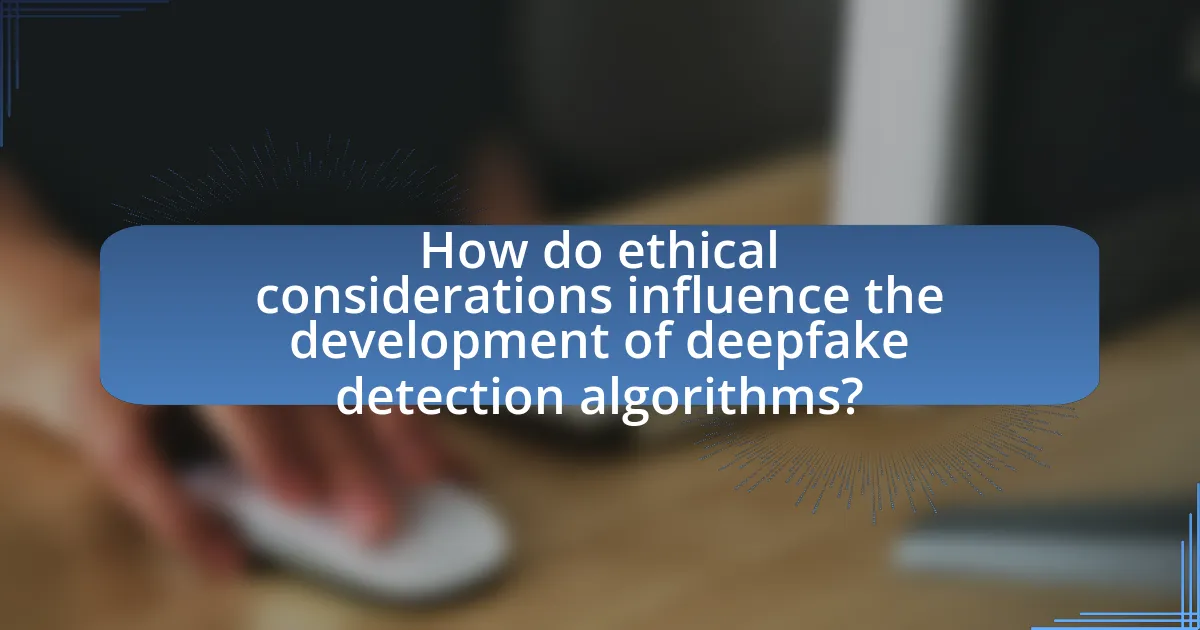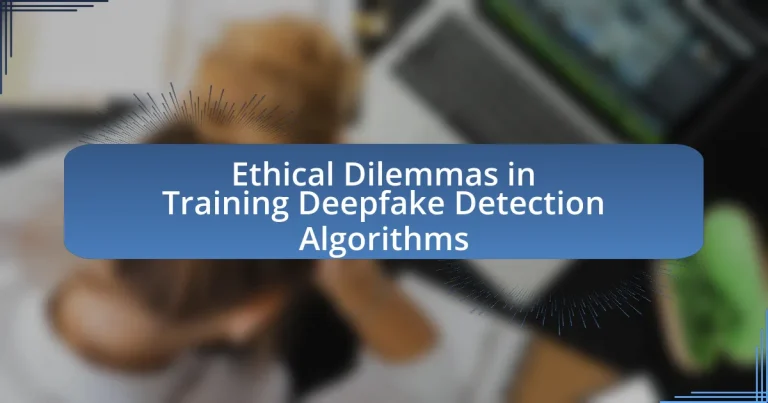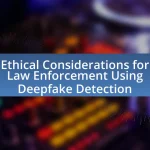The article focuses on the ethical dilemmas associated with training deepfake detection algorithms, highlighting critical issues such as data privacy, consent, and the potential misuse of technology. It emphasizes the importance of ethical guidelines to ensure responsible algorithm development, addressing concerns about bias in training data and the implications of ignoring these ethical considerations. The discussion includes the impact of biased datasets on algorithm performance, the necessity for transparency, and the role of collaborative efforts among technologists, ethicists, and regulatory bodies in promoting ethical practices. Ultimately, the article advocates for best practices in training deepfake detection algorithms to foster accountability and public trust.

What are Ethical Dilemmas in Training Deepfake Detection Algorithms?
Ethical dilemmas in training deepfake detection algorithms primarily revolve around issues of data privacy, consent, and potential misuse of technology. The training of these algorithms often requires large datasets of images and videos, which may include personal data without explicit consent from individuals, raising significant privacy concerns. Furthermore, the potential for deepfake technology to be used maliciously, such as in creating misleading or harmful content, poses ethical questions about the responsibility of developers and researchers in ensuring their algorithms are not used for nefarious purposes. Studies, such as those published in the Journal of Artificial Intelligence Research, highlight the need for ethical guidelines and frameworks to govern the development and deployment of deepfake detection technologies, emphasizing the balance between innovation and ethical responsibility.
Why is it important to address ethical dilemmas in this context?
Addressing ethical dilemmas in the context of training deepfake detection algorithms is crucial to ensure the responsible use of technology. Ethical considerations directly impact public trust, as the misuse of deepfake technology can lead to misinformation, privacy violations, and potential harm to individuals. For instance, a study by the University of California, Berkeley, highlights that deepfakes can significantly influence public opinion and political outcomes, emphasizing the need for ethical frameworks to guide algorithm development. By addressing these dilemmas, developers can create systems that prioritize transparency, accountability, and fairness, ultimately fostering a safer digital environment.
What specific ethical concerns arise during the training process?
During the training process of deepfake detection algorithms, specific ethical concerns include data privacy, consent, and potential bias. Data privacy issues arise when using personal images or videos without explicit consent, violating individuals’ rights. Consent is crucial, as individuals should be informed about how their data will be used, especially in sensitive contexts. Additionally, potential bias can occur if the training data lacks diversity, leading to algorithms that perform poorly on underrepresented groups, which raises fairness and accountability issues. These concerns highlight the need for ethical guidelines and practices in the development of such technologies.
How do these dilemmas impact the effectiveness of detection algorithms?
Ethical dilemmas significantly reduce the effectiveness of detection algorithms by introducing biases and limitations in training data. When algorithms are trained on datasets that reflect ethical biases, such as underrepresentation of certain demographics, their ability to accurately detect deepfakes across diverse populations diminishes. For instance, a study by Korshunov and Marcel (2018) demonstrated that detection algorithms trained predominantly on images of specific ethnic groups performed poorly on others, leading to higher false negative rates. This indicates that ethical considerations in dataset selection directly influence the reliability and overall performance of detection algorithms.
What are the potential consequences of ignoring these ethical dilemmas?
Ignoring ethical dilemmas in training deepfake detection algorithms can lead to significant societal harm, including the proliferation of misinformation and erosion of public trust. When developers overlook ethical considerations, they may inadvertently create systems that are biased or ineffective, allowing malicious deepfakes to spread unchecked. For instance, a study by the MIT Media Lab found that biased training data can result in algorithms that misidentify individuals based on race or gender, exacerbating existing inequalities. Additionally, the lack of ethical oversight can lead to legal repercussions for organizations, as they may violate privacy laws or face backlash from the public. Ultimately, neglecting these dilemmas risks undermining the integrity of technology and its potential benefits to society.
How can biased training data affect algorithm performance?
Biased training data can significantly degrade algorithm performance by leading to inaccurate predictions and reinforcing existing stereotypes. When algorithms are trained on data that lacks diversity or is skewed towards certain demographics, they may fail to generalize effectively to broader populations. For instance, a study by Buolamwini and Gebru (2018) demonstrated that facial recognition systems exhibited higher error rates for darker-skinned individuals and women, primarily due to underrepresentation in the training datasets. This bias not only affects the reliability of the algorithm but also raises ethical concerns regarding fairness and accountability in applications such as deepfake detection, where misidentification can have serious consequences.
What risks do unethical practices pose to society?
Unethical practices pose significant risks to society by undermining trust, promoting misinformation, and exacerbating social inequalities. For instance, the proliferation of deepfake technology, when used unethically, can lead to the creation of misleading content that damages reputations and influences public opinion, as evidenced by incidents where manipulated videos have swayed electoral outcomes. Furthermore, unethical practices in algorithm training can perpetuate biases, resulting in discriminatory outcomes that disproportionately affect marginalized communities, as highlighted in studies showing that biased datasets lead to flawed AI decisions. These risks collectively threaten social cohesion and the integrity of democratic processes.

How do ethical considerations influence the development of deepfake detection algorithms?
Ethical considerations significantly influence the development of deepfake detection algorithms by prioritizing the protection of individual privacy and preventing misuse of technology. Developers must ensure that these algorithms do not inadvertently reinforce biases or lead to false accusations against innocent individuals. For instance, ethical frameworks advocate for transparency in how algorithms are trained and the datasets used, which helps mitigate risks of discrimination. Furthermore, adherence to ethical guidelines can enhance public trust in the technology, as seen in initiatives like the Partnership on AI, which emphasizes responsible AI development. This focus on ethics ultimately shapes the design and implementation of detection algorithms to align with societal values and legal standards.
What role does transparency play in ethical algorithm training?
Transparency is crucial in ethical algorithm training as it fosters accountability and trust in the decision-making processes of algorithms. By providing clear insights into how algorithms are developed, trained, and evaluated, stakeholders can better understand the potential biases and limitations inherent in these systems. For instance, research by the AI Now Institute highlights that transparency in algorithmic processes can lead to more equitable outcomes by allowing for scrutiny and feedback from diverse communities, thereby reducing the risk of perpetuating harmful stereotypes or misinformation.
How can developers ensure transparency in their methodologies?
Developers can ensure transparency in their methodologies by documenting their processes, decisions, and data sources comprehensively. This documentation should include clear descriptions of the algorithms used, the datasets employed for training, and the rationale behind design choices. For instance, the use of open-source frameworks allows for peer review and scrutiny, which enhances transparency. Additionally, adhering to established ethical guidelines, such as those proposed by the Partnership on AI, can provide a framework for responsible practices. By making this information publicly accessible, developers can foster trust and accountability in their work, particularly in sensitive areas like deepfake detection.
What are the implications of a lack of transparency?
A lack of transparency in training deepfake detection algorithms can lead to significant ethical implications, including the perpetuation of bias and misinformation. When the processes and data used to train these algorithms are not disclosed, it becomes difficult to assess their fairness and accuracy, potentially resulting in discriminatory outcomes against certain groups. For instance, studies have shown that biased training data can lead to higher error rates for specific demographics, undermining the reliability of the technology. Furthermore, without transparency, stakeholders cannot hold developers accountable for the consequences of their algorithms, which can exacerbate the spread of deepfakes and erode public trust in digital media.
How can ethical guidelines be established for training these algorithms?
Ethical guidelines for training algorithms can be established through a multi-stakeholder approach that includes input from ethicists, technologists, policymakers, and affected communities. This collaborative framework ensures that diverse perspectives are considered, leading to guidelines that address potential biases and societal impacts. For instance, the IEEE Global Initiative on Ethics of Autonomous and Intelligent Systems has developed a set of ethical principles that emphasize transparency, accountability, and fairness in algorithmic design. These principles serve as a foundation for creating ethical guidelines that can be adapted to specific contexts, such as deepfake detection, ensuring that the algorithms are trained responsibly and ethically.
What frameworks currently exist for ethical AI development?
Several frameworks currently exist for ethical AI development, including the IEEE Global Initiative on Ethics of Autonomous and Intelligent Systems, the EU’s Ethics Guidelines for Trustworthy AI, and the Partnership on AI’s Tenets. The IEEE framework emphasizes the importance of ethical considerations in the design and implementation of AI systems, advocating for transparency, accountability, and inclusivity. The EU guidelines outline key requirements for AI systems to be lawful, ethical, and robust, focusing on human oversight and societal well-being. The Partnership on AI promotes best practices and shared understanding among stakeholders to ensure AI benefits all of society. These frameworks provide structured approaches to address ethical dilemmas in AI, including those related to deepfake detection algorithms.
How can these frameworks be applied to deepfake detection?
These frameworks can be applied to deepfake detection by utilizing machine learning algorithms that analyze patterns in video and audio data to identify inconsistencies indicative of manipulation. For instance, convolutional neural networks (CNNs) can be trained on large datasets of both authentic and deepfake media to learn distinguishing features, such as unnatural facial movements or audio mismatches. Research by Korshunov and Marcel (2018) demonstrated that such models could achieve over 90% accuracy in detecting deepfakes, validating the effectiveness of these frameworks in real-world applications.

What are the best practices for ethically training deepfake detection algorithms?
The best practices for ethically training deepfake detection algorithms include ensuring transparency, obtaining informed consent, and using diverse datasets. Transparency involves clearly documenting the data sources and methodologies used in training, which fosters trust and accountability. Informed consent requires that individuals whose data is used are aware and agree to its use, thereby respecting their rights and privacy. Utilizing diverse datasets helps to mitigate bias, ensuring that the algorithms perform effectively across different demographics and scenarios. These practices are supported by ethical guidelines from organizations like the IEEE and the Partnership on AI, which emphasize the importance of fairness, accountability, and transparency in AI development.
How can developers mitigate bias in training data?
Developers can mitigate bias in training data by employing diverse datasets that represent various demographics and contexts. This approach ensures that the training data encompasses a wide range of perspectives, reducing the likelihood of biased outcomes. For instance, studies have shown that models trained on more inclusive datasets perform better across different groups, as evidenced by research from the MIT Media Lab, which highlighted that facial recognition systems trained on diverse datasets significantly reduced error rates for underrepresented groups. Additionally, developers can implement techniques such as data augmentation and adversarial training to further enhance the robustness of their models against bias.
What strategies can be employed to diversify training datasets?
To diversify training datasets, one effective strategy is to incorporate data from multiple sources and demographics. This can be achieved by collecting data from various geographical locations, cultural backgrounds, and age groups to ensure a comprehensive representation of the target population. For instance, research indicates that diverse datasets improve model performance and reduce bias, as seen in studies like “Fairness and Abstraction in Sociotechnical Systems” by Selbst et al., which highlights the importance of varied data in mitigating algorithmic bias. Additionally, augmenting existing datasets through techniques such as data synthesis, oversampling underrepresented classes, and using generative models can further enhance diversity. These methods not only enrich the dataset but also contribute to the robustness and fairness of machine learning models, particularly in sensitive applications like deepfake detection.
How can ongoing evaluation help maintain ethical standards?
Ongoing evaluation helps maintain ethical standards by ensuring that practices and outcomes are continuously assessed against established ethical guidelines. This process allows organizations to identify and address potential ethical breaches in real-time, fostering accountability and transparency. For instance, regular audits of deepfake detection algorithms can reveal biases or inaccuracies that may lead to harmful consequences, thereby enabling timely corrective actions. Research indicates that continuous monitoring can significantly reduce the risk of ethical violations, as evidenced by studies showing that organizations with robust evaluation frameworks report fewer ethical lapses.
What collaborative efforts can enhance ethical practices in this field?
Collaborative efforts that can enhance ethical practices in training deepfake detection algorithms include the establishment of interdisciplinary partnerships among technologists, ethicists, and policymakers. These collaborations can lead to the development of comprehensive ethical guidelines that address the potential misuse of deepfake technology. For instance, initiatives like the Partnership on AI, which includes members from academia, industry, and civil society, work towards creating standards and best practices for AI technologies, ensuring that ethical considerations are integrated into the development process. Additionally, joint research projects can facilitate the sharing of data and methodologies, promoting transparency and accountability in algorithm training. Such collaborative frameworks are essential for fostering a responsible approach to the challenges posed by deepfake technology.
How can partnerships between tech companies and ethicists improve outcomes?
Partnerships between tech companies and ethicists can improve outcomes by ensuring that ethical considerations are integrated into the development of technologies, particularly in sensitive areas like deepfake detection. By collaborating, tech companies can leverage the expertise of ethicists to identify potential ethical dilemmas, such as privacy concerns and misinformation risks, that may arise from the deployment of deepfake technologies. For instance, the partnership can lead to the establishment of guidelines that prioritize user consent and transparency, thereby fostering public trust. Research indicates that ethical frameworks can enhance the accountability of AI systems, as seen in the work by Jobin, Ienca, and Andorno (2019) in “The Global Landscape of AI Ethics Guidelines,” which highlights the importance of ethical oversight in technology development.
What role do regulatory bodies play in promoting ethical training?
Regulatory bodies play a crucial role in promoting ethical training by establishing guidelines and standards that ensure responsible practices in the development and deployment of technologies, including deepfake detection algorithms. These organizations, such as the Federal Trade Commission (FTC) and the European Data Protection Board (EDPB), create frameworks that mandate transparency, accountability, and fairness in algorithmic training processes. For instance, the General Data Protection Regulation (GDPR) emphasizes the importance of data protection and ethical considerations in AI, requiring organizations to conduct impact assessments and ensure that training data is used responsibly. By enforcing compliance with these regulations, regulatory bodies help mitigate risks associated with unethical practices, thereby fostering a culture of ethical awareness and responsibility in technology development.
What practical steps can developers take to ensure ethical training of deepfake detection algorithms?
Developers can ensure ethical training of deepfake detection algorithms by implementing diverse and representative datasets. Utilizing datasets that include a wide range of demographics, contexts, and scenarios helps mitigate bias and enhances the algorithm’s ability to generalize across different types of deepfakes. Research indicates that biased training data can lead to ineffective detection in real-world applications, as seen in studies highlighting the performance disparities across various demographic groups. Additionally, developers should prioritize transparency in their methodologies, documenting data sources and training processes to facilitate accountability. Regular audits and updates of the algorithms based on emerging deepfake techniques are also essential to maintain effectiveness and ethical standards.


